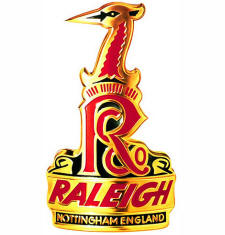
Click links below to view the Raleigh bikes in our collection:
1982 Trail Rider
1985 Elkhorn
1985 Seneca
1987 Seneca
1987 Edge
1992 Chill Police Edition
1993 Tomac Replica
Raleigh Specs
|
For specs on the pre-1990 Raleigh bikes Click Here |
|
| 1887-1982 | |
|
In 1887, Frank Bowden purchased a small bicycle shop on Raleigh Street in Nottingham, England. The Raleigh shop had created a safety style bike with a chain driven front wheel. Bowden soon expanded to a 5 story factory to meet the increased demand. The increased production allowed Bowden to show 23 designs at the 1890 Stanley Cycle show. In 1892, A.A. Zimmerman, Champion of the World, was riding a Raleigh bike featuring the first radial laced wheel and coming in at 24 pounds. Raleigh continued to innovate with the tubular fork crown in 1892, cross frames in 1896 and a silent freewheel hub and "back pedaling" brake in 1899. Raleigh was also the first to manufacture the 3 speed hub under the Sturmey-Archer name. In 1923, they introduced a lug less racing frame and a quick release rear fork end in 1925. In 1939, a folding bike was designed for Paratroopers to use in WWII. After the war, Raleigh introduced rims that worked with caliper and pull-up brakes as well as new metallic finishes. In 1965, the RSW 16 was introduced as a true transportation bike featuring 16" balloon tires and 3 speeds. When the muscle bikes took off in the late 1960's Raleigh answered with the popular Chopper. Raleigh was one of the more popular brands during the bike boom of the 1970's with a wide range of road bikes. In 1982, the Huffy Corporation licensed the right to manufacture and distribute Raleigh in the USA. Huffy was given instant access to bike shops with a proven brand. When looking at bikes from 1982 and newer, you must make sure which company made the bike. The Raleigh Cycle Company of America sold bikes in the US while the rest of the world, including Canada, received Raleigh Cycle Company of England bikes. The following information is for the US bikes only. |
|
| 1982 | |
|
The 1982 Trail Rider is something of a quasi-mountain bike since it still uses the one-piece crank design, high rise handlebars, spring cruiser seat and caliper brakes. The bike features a unique twin lateral frame similar to the original Breezer bikes. | |
| 1983 | |
|
Only one mountain bike is available for 1983, the Trail Rider. Parts are pretty typical for the era and include a TA Cyclo Tourist crank, BMX pedals, Suntour derailleurs, gold alloy rims, gum wall knobby tires, bars with a bolt-on cross brace and full Cro-moly frame. Raleigh USA made the decision to sponsor the United States Cycling Team for the upcoming Pan-Am and Olympic games. |
|
| 1984 | |
|
1984 Raleigh "catalog": 
 Raleigh used a process to thermally bond dissimilar materials to produce frames for the Olympic team. The result was 3 gold medals, one silver and one bronze. A bike made with this bonding process was also made for Pete Penseyres who used it to win the 3170 mile 1984 Race Across America (RAAM) The only 1984 "catalog" that we have been able to find is a two page fold out that does not have many details. The Crested Butte uses the 555 MT double butted tubing, Deore XT "deer head" components, crown type fork, multi-pressure center ridge tires and Suntour XC II pedals. The Elkhorn appears to use a mid-grade Suntour component groups and a similar frame and fork to the Crested Butte. Three lower end models, the Tamarack, Yukon (caliper brakes, 12 speeds) and Grand Mesa (caliper brakes) look to be more city-oriented bikes. All models use bull moose one piece bar/stem combos. March 1984 Raleigh ad: 
 |
|
| 1985 | |
|
Five models are available for 1985 under the Mountain Tour series. The Crested Butte (29 pounds) is the top model and features a Shimano Deore XT drive train, full 575 Cro-moly frame and Suntour XC-II pedals. Next down in the Elkhorn (30 pounds) with Suntour AG derailleurs, 575 Cro-moly main frame and AT-50 brakes. The Seneca (32 pounds) uses the Shimano Z series components and a 575 Cro-moly main frame. The Teton (35 pounds) and Grand Mesa (36 pounds) are the 2 entry level models.. All bikes use a bull moose one-piece bar and stem combo and Raleigh center ridge directional tires (2.125" except on the Grand Mesa which uses 1.5" tires). The top three models use a leather portage strap that attaches via braze-ons on the frame. The Portage is a touring bike equipped with XT components and uses 650b wheels. Bike reviews from the June 1985 Mountain Biking for the Adventure magazine including the Raleigh Elkhorn. 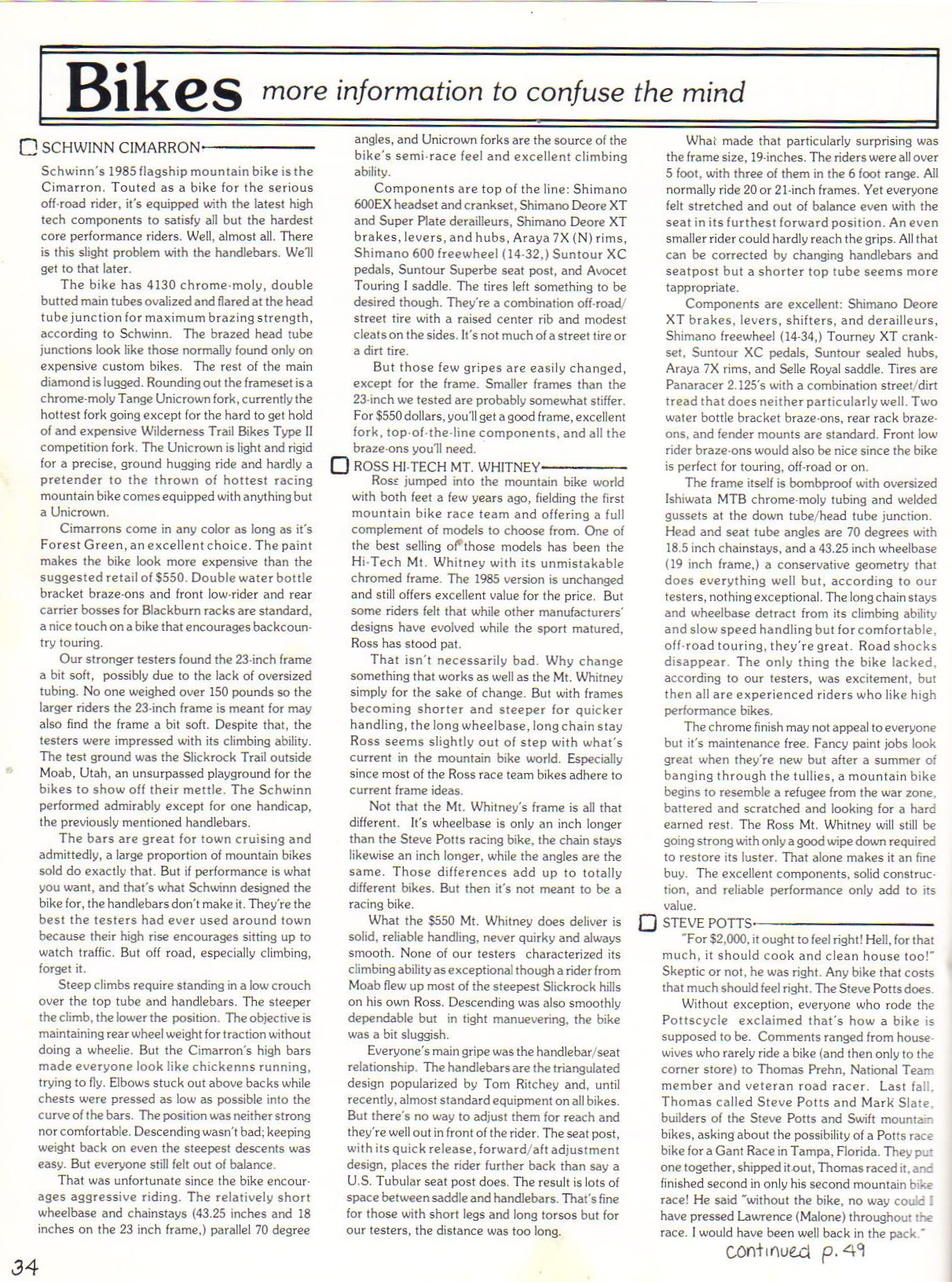
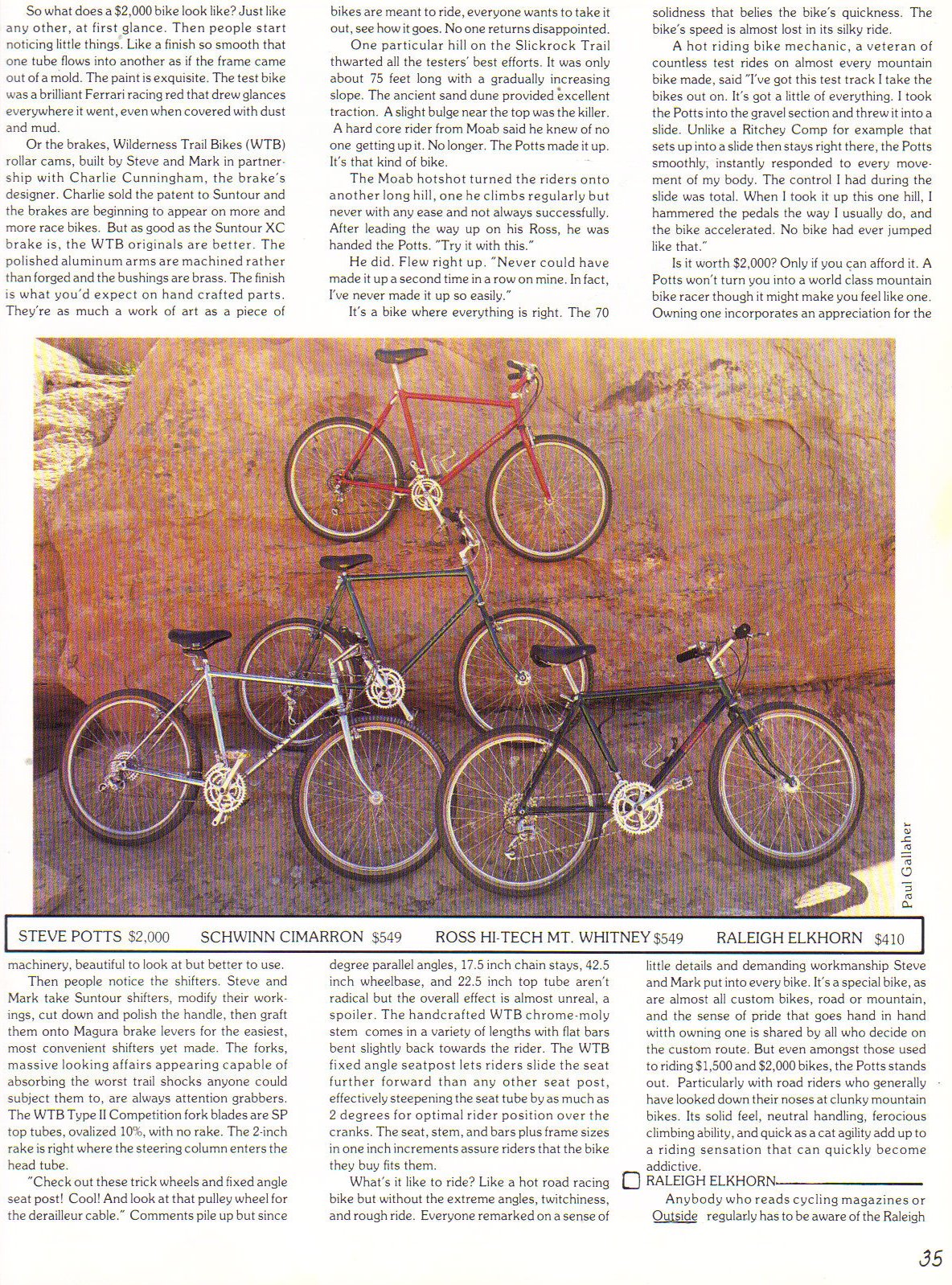
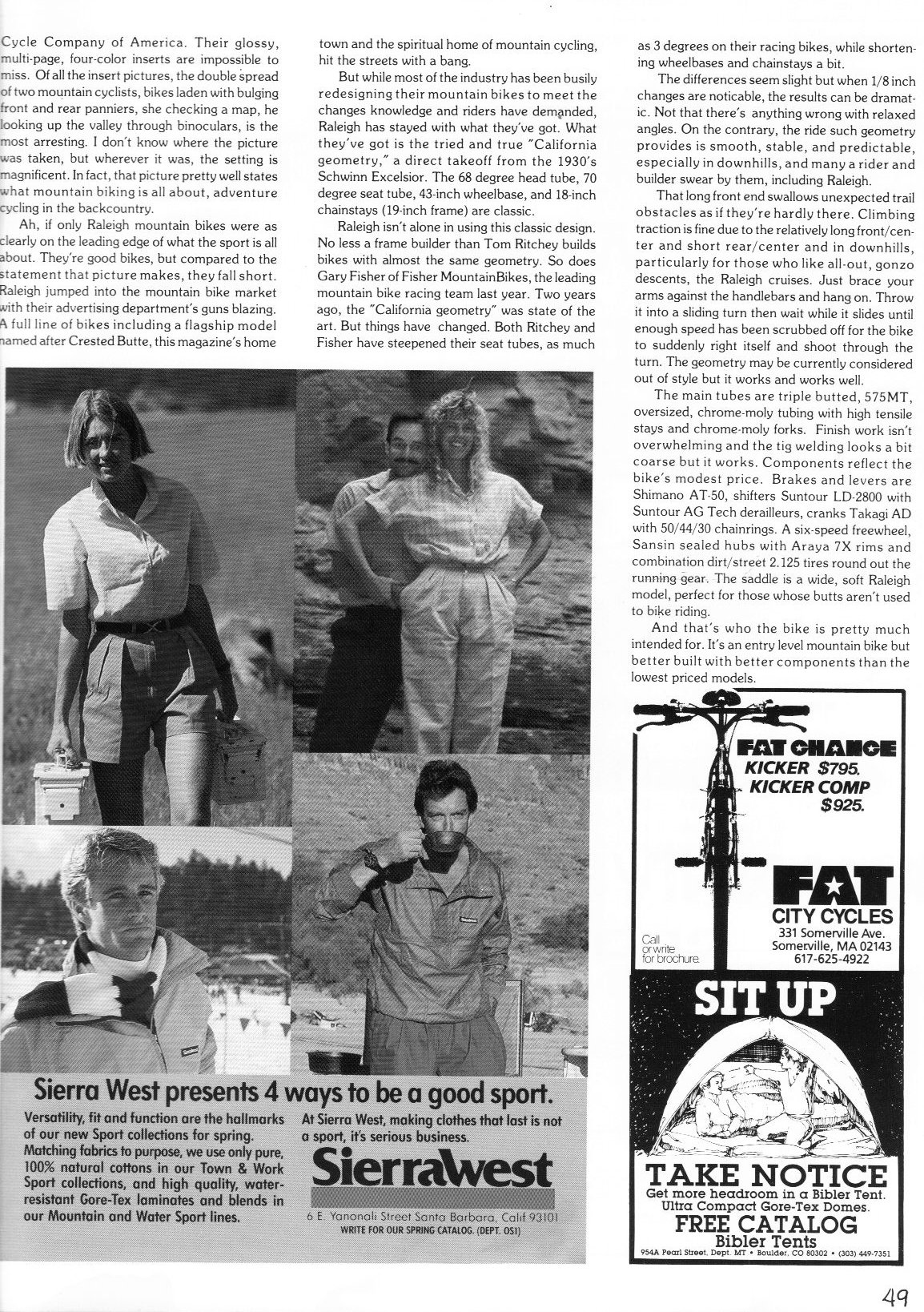 |
|
| 1986 | |
|
While producing the 1984 Olympic bikes, Raleigh came up with a process to thermally bond dissimilar materials. Each bike was reported to cost $40,000 to produce. Raleigh decided to apply this process to their 1986 line of bikes. For the first year, it was limited to a series of sport touring road bikes (440, 460 and 480) which joined aluminum main tubes to steel lugs. They named the process Technium and it was produced in a new Seattle area factory. Since the new Technium series soaked up most of the R&D dollars, the mountain bikes were virtually unchanged. The Crested Butte is virtually unchanged from 1985, the Elkhorn switches to XC Sport derailleurs and the Seneca is also identical to the 1985 model (colors are even the same). The Teton and Grand Mesa continue on as the entry level models. The top three models all lose 1/2 pound which is more likely a marketing change as opposed to an actual weight difference. The 650b equipped Portage touring bike also continues into the new year virtually unchanged as well. A Technium frame made using Easton aluminum/Kevlar/graphite composites was was used by Pete Penseyers to win the 1896 RAAM in a record time. The Huffy licensing deal expires and rights to use the Raleigh name in the USA reverts back to Tube Investments. |
|
| 1987 | |
|
1987 sees the expansion of the Technium process to a couple of new lines of bikes but it doesn't make it to the mountain bikes yet. In addition to the 400 series sport touring bikes, a line of Scott Tinley Tri-Lite bikes were added. The Technium City-Lite also appears with 26" wheels but with high-rise bars, 1.5" tires and a rear drum brake. The Mountain Tour line-up is reduced to three models: the Elkhorn (Deore SIS, Bio Pace, chain stay mounted U brake), Seneca (Suntour XC7000, canti brakes) and Grand Teton (Suntour Alpha 3000, canti brakes). The geometries have been tightened up a bit and the colors are from the pastel palette as opposed to the earlier bikes rich metallic colors. The big news on the mountain bike side would be the introduction of the Edge Mountain Trials bike. The bike was designed bike John Olsen and used a 24" rear wheel/26" front combination, Deore SIS parts and a Suntour chain stay mounted Roller Cam brake. The head tube has been heavily gusseted and Raleigh is one of the first major companies to offer a true trials bike. There is no bike with the new Deore XT index group which is extremely popular in 1987. The Raleigh Technical Center designs new composite aerodynamic bikes for the 1987 Pan Am and World Championship games. Raleigh is sold to Derby International who will also acquire Kalkhoff, Nishiki, Univega, Haro, Cycle Pro and late in 1999, Diamondback. March 1987 Raleigh Edge ad w/ John Olsen 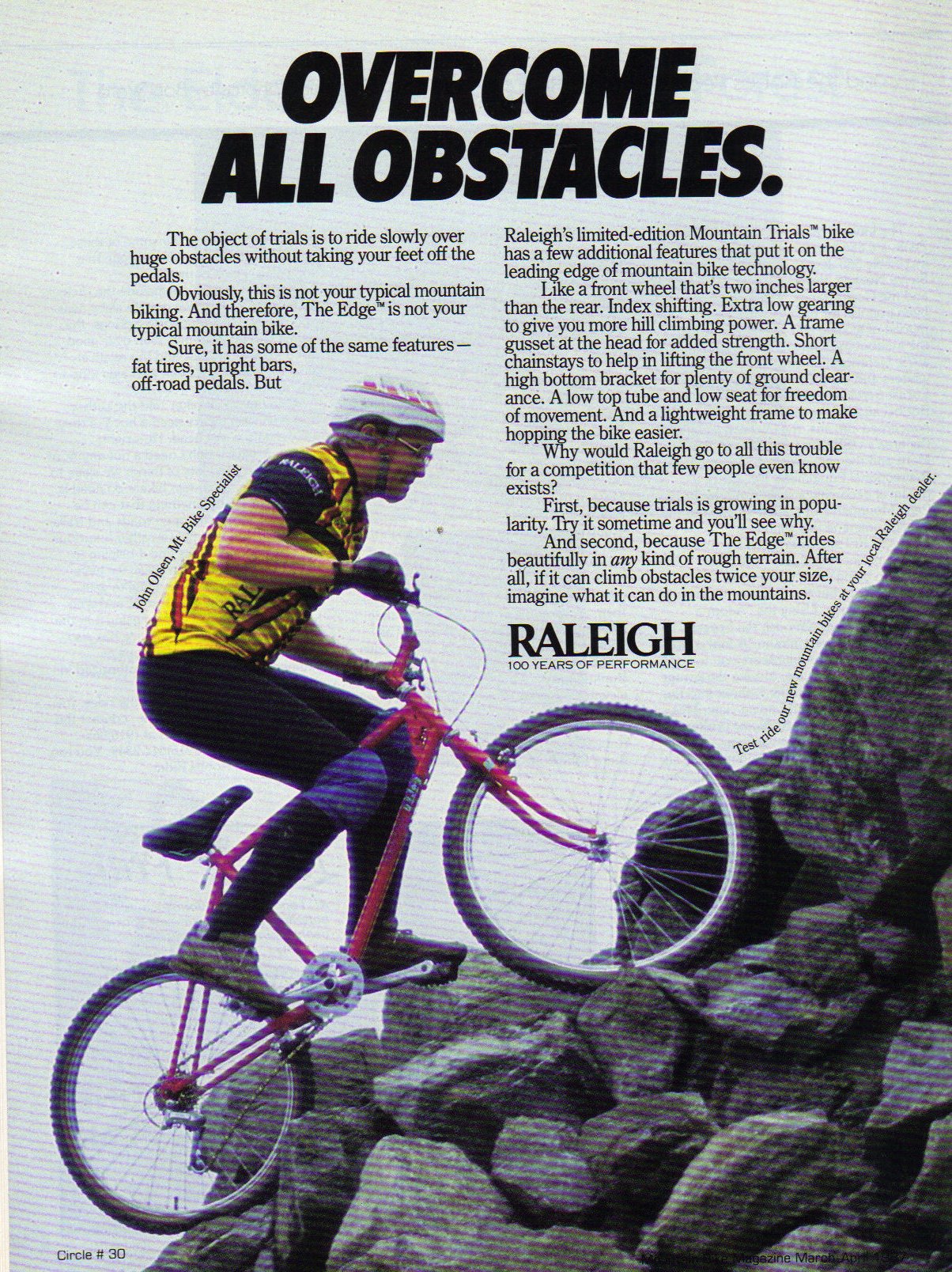 |
|
| 1988 | |
|
The US Cycling Team is once again using Raleigh bikes for the Olympics. The new frames are an E-9 composite Kevlar/aluminum laminate sealed together with the Technium process. On the mountain bike side, they big news is the introduction of the Technium mountain bikes (finally). Mountain bikes also appear first in the catalog. All Technium mountain bikes use a Monostay Wishbone on the rear and chain stay mounted brakes. The Vision uses main tubes constructed form Easton C9 Carbon/Kevlar/Aluminum tubes bonded to Cro-moly lugs. The regular Vision uses the new Suntour XCD parts while the Team version offers the Electronic Browning Transmission. The aluminum Technium line consists of three models: the Peak (Shimano Deore XT, RM20, IRC X-1 tires), Chill (Shimano Deore, RM25) and Instinct (Suntour Alpha 4050). The Edge Mountain Trials bike continues on virtually unchanged from 1987. |
|
| 1989 | |
|
The Technium bikes continue on for 1989 but are placed behind the road bikes in the catalog. All mountain bike switch to rear cantilever brakes and straight bladed forks. The Peak (6061 E-9, XT II, thumb shifter) uses a unique anodization process on the main tubes which is very scratch resistant and the graphics are actually part of the anodization. Other models include the Chill (Deore II, thumb shift), Frenzy (Mountain LX), Killer Instinct (Suntour XCD 6000) and Heat (Suntour XCM, thumb shift). All of these models use internal rear brake cable routing and a rear Monostay. The Technium technology is also applied to a lower end line of bikes with a traditional rear end and lower end parts. Models include the Obsession, Flashpoint and Ovation. The Edge Mountain Trials bike still has a small picture in the catalog and is most likely carried over to help move left over inventory. The Vision is listed as being available as a frame only (E-9 aluminum/carbon fiber/Kevlar main tubes) |
|
| 1990 | |
|
1990 brings a host of improvements to the Technium line including a new geometry with shorter chain stays and longer top tubes. The aluminum head lug is now cold forged to save .25 pounds and accommodates the new 1 1/8" oversize head set that are becoming popular. The derailleur cable stops are now slotted and the rear brake cable is now external with housing stops integrated into a ring that goes between the frame tubing and the lugs. Straight bladed forks are used across the model line. The Peak (E-9 anodized main tubes, XT Rapid Fire) continues as the top model followed by the Chill (anodized E-9, Deore DX Rapid Fire), Instinct LX (E9 anodized, Deore LX Rapid Fire), Instinct XCD (Suntour XCD 6000, anodized E-9), Heat (6061 T8, painted, 500 LX) and Obsession (6061 T8 painted, 300 LX). There is also a line of lighter duty "urban ATB" line. Once again, mountain bikes follow the road bikes in the catalog. Raleigh must have finally sold off the remaining stock of Vision frames and Edge trials bikes since neither appear in the catalog. |
|
| 1991 | |
|
Raleigh continues to fine tune the Technium line. 1991 brings a new cold forged seat lug (.25 pound weight savings), new vertical drop out design and a TIG welded rear end for improved rear tire clearance. The Peak (E-9 anodized, Tange Big Fork, XT Rapid Fire) is the top model once again and is followed by the Chill (E-9 anodized, Deore DX Rapid Fire, Tange Big Fork), Instinct (anodized 6061 T8, Shimano Deore LX), Heat (anodized 6061 T8, Shimano 500LX) and Obsession (Shimano 400LX, anodized aluminum). There is a new Altimetric series of steel bikes that are sill off-road oriented but at a lower price. Models are the Tangent (Deore LX), Traverse (Shimano 400LX), Tactic (Suntour XCM) and Talon (Shimano 200 GS). Below this, there is another line of "Urban All-Terrain" bikes for more city-oriented riding. On the racing front, John Tomac joins the Raleigh team and brings one of the most accomplished and recognized racer to the Raleigh camp. Since bikes are spec'ed so far in advance, Tomac has little input for the 1991 bikes and is not mentioned in the catalog. Road bikes are still at the front the catalog. 1991 Tomac Raleigh ad: 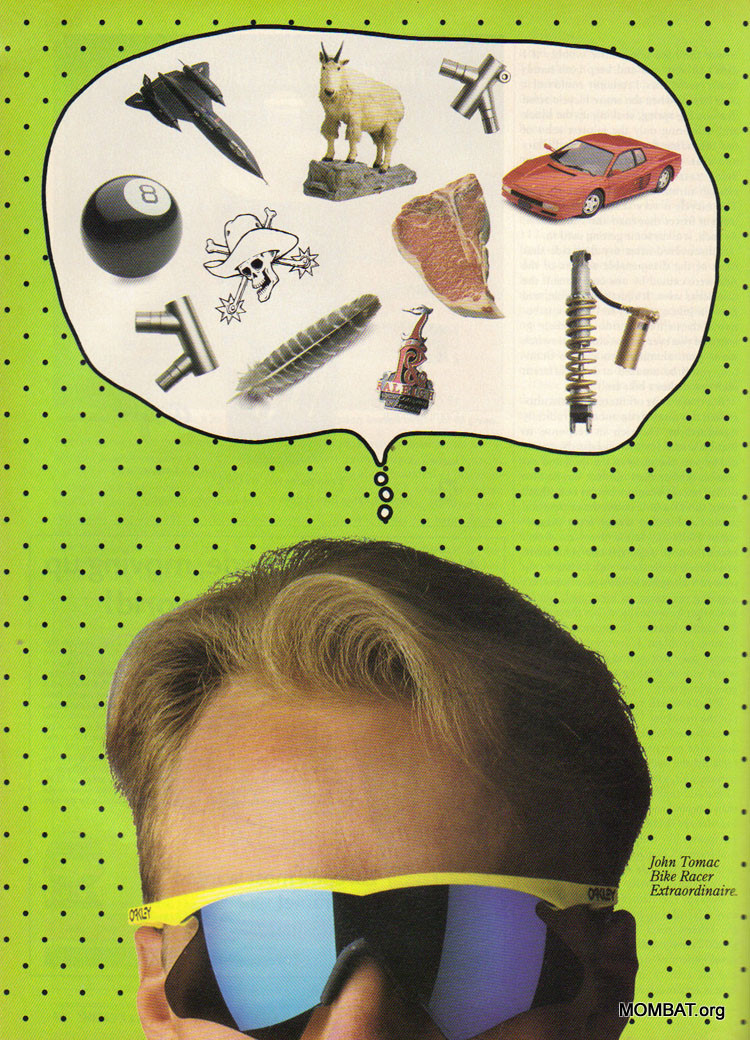
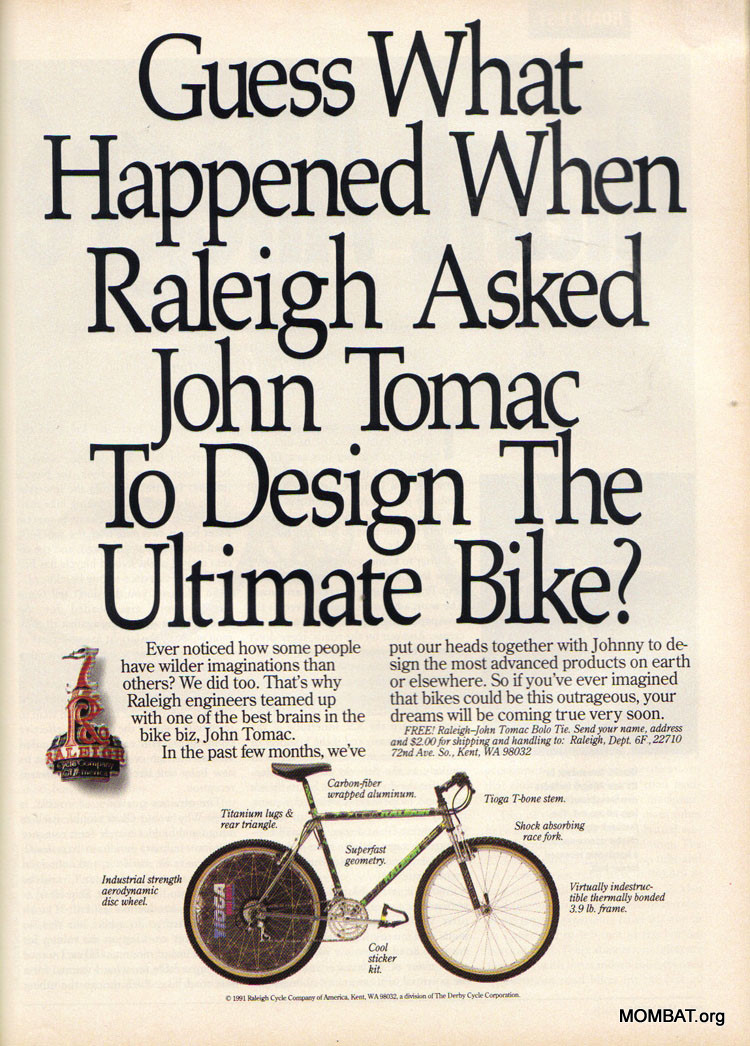 |
|
| 1992 | |
|
In 1992, John Tomac makes his presence felt in the design and marketing departments. John makes and appearance on the catalog cover and is credited with helping in the new mountain bike design. He is quoted as saying "Keep the front end stiff, so it goes where I point it!" The answer from Raleigh is Rigid Point Design (RPD). The oversized top tube, oversized head set, large diameter stem and the constant diameter fork blades combine with a sloping tube tube to increase the rigidity of the front end of the bike. The Sheer takes over the top spot combining Easton C9 carbon fiber and E9 aluminum which is bonded to cold forged lugs and Cro-moly stays. Components are the Shimano Deore XT with a Rock Shox Mag 20, XT clip-less pedals and an Aheadset. The Peak goes to a full E9 main frame with a threaded aluminum rigid fork, Deore XT parts and XT clip-less pedals. The Chill uses the Shimano Deore DX group with a rigid fork and E9 frame (also available as a Police Edition). The Heat rounds out the Technium line with a 6061 T8 frame and a Shimano Deore LX/DX mix. The Tangent, Crest, Talon, Summit and Glacier make up the steel offerings. The Technium models used anodized main tubes including the graphics. Tires are a mix of black wall and natural skin walls. All Technium frames use 1.375" top and down tubes with a 1.25" seat tube. Head lugs and seat lugs are cold forged aluminum to help save weight. Traditional threaded steerer tubes are still found on all models. Mountain bikes appear at the front of the catalog, likely helped by the investment in Tomac By 1992, Derby was the largest cycle group in the world, with sales of $500m. 1992 French edition Raleigh catalog which includes some USA produced bikes: 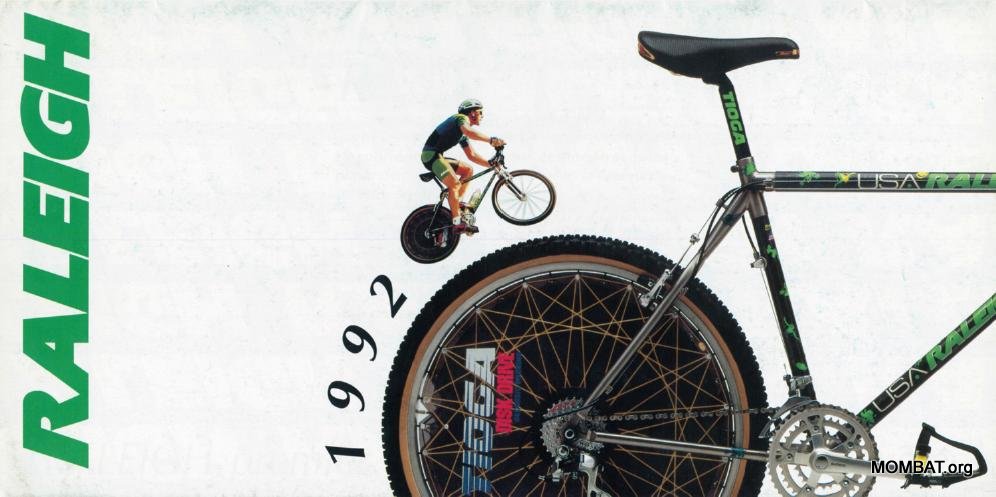

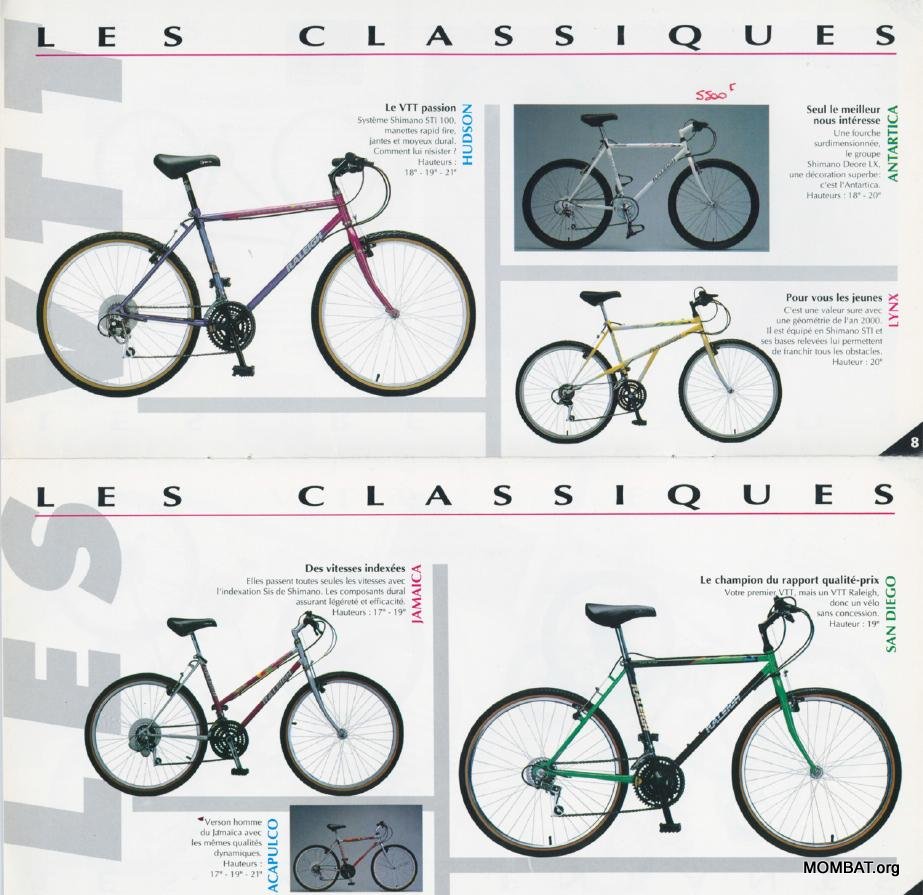

|
|
| 1993 | |
|
1993 was a busy year at Raleigh. The Tomac influence is now in full swing with a new John Tomac Signature bike, new titanium bikes and a redesigned Technium frame. The John Tomac Signature was likely one of the most expensive bikes of its time at roughly $6,300 retail. Approximately 60 bikes were made and the spec seems to vary depending on availability and different sponsorship obligations. Some of the Raleigh literature mentions the bikes being built to the spec that Tomac was riding that week. The frames used a Litespeed-sourced rear triangle and head tube assembly with the E-9 carbon wrapped tubes in the main frame. The fame was assembled using the Technium process. Tioga was one of the main sponsors and supplied the headset, bar ends, handlebars, seat post, Revolver cranks, Tension disk rear wheel and Psycho tires. The first bikes used the Rock Shox Mag 21 suspension fork but it was replaced with the Tioga fork when it became available. Most of the Tioga parts were finished in blue which looked nice with the natural Ti and carbon of the frame. Shimano supplied an XTR drive train and most of the bikes used Grafton brakes and levers (although XTR brakes are shown in the catalog). Two new full titanium models also bore the Tomac signature. The Mti2000 used a very similar parts spec to the Signature bike while the MTi1000 used a Shimano LX/XT parts mix with a Tange Struts fork. Both bikes used a fair amount of Tioga branded parts in keeping with the spirit of the Tioga sponsorship of Tomac. The Technium line gets a major reworking. The down tube and top tube are TIG welded to the head tube as opposed to the previous method of bonding the two tubes to a forged head tube. The TIG welded rear Monostay and chain stay assembly is now TIG welded to a steel seat tube. The seat tube had been an aluminum tube that was banded into the seat and bottom bracket lugs. This new method reduced several steps making the bike easier to produce plus reduced the number of lugs with a corresponding drop in weight. The models names also switch to an alpha-numeric system. M for mountain bike and Ti for Titanium and T for Technium. Models include the MT600 (LX/XT, Tange struts, Tange Prestige seat tube, double butted main tubes), MT500 (LX, Tange Big Fork, Tange Prestige seat tube, double butted main tubes). The lower models used the older style bonded head lug assembly. Models include the MT400 (Exage ES/LT, elastomer suspension fork), MT300 (Altus A10, rigid fork) and MT200 (Altus A20/C10, rigid). Bikes from the MT500 and up use the thread less Ahead system while bike below the MT500 use a threadless system. All tires have black sidewalls. Rigid Point Design is still used along with the Monostay on the Ti and Technium models. The entry level range included the M50LT (suspension), M50, M40 and M30. |
|
| 1994 | |
|
Sadly, 1994 will mark the final year of Tomac and Technium. Near the end of the year, John moves on to Giant bikes. XTR components disappear from the Raleigh line so the top model is equipped with an XT/LX mix with Grip Shift and a Rock Shox Mag 21 fork. There are two bikes equipped this way: the MTi1000 with a titanium frame and the MT700 with the Technium frame. The rest of the Technium line of bikes: MT500 (LX, Rock Shox Mag 10), MT400 (STX Rock Shox Quadra), MT300 (STX, rigid) and MT200 (Alivio/STX, rigid). The steel framed bikes are all now rigid: M60, M50, M40, M30 and M20. The MT300 and above all use the thread less Ahead system. All tires are black walls except the gum/beige colored Tioga Psycho tires on the MTi1000. All Technium an Ti bike still use the Monostay and Rigid Point Design.. The MT300-MT700 use an ovalized seat tube for increased lateral stability at the bottom bracket. |
|
| 1995 | |
|
While many manufacturers are expanding their offering, especially in the upper price range, Raleigh shifts gears and head down market. The first two pages of the catalog talk about the USA made bikes but nothing about technology. The catalog also starts with the low end bikes first which shows the change in priorities. The M9000 marks the first full suspension Raleigh (a good 3-4 years aftermost other makes) and it is a modest effort. A seat tube mounted rocker arm attached to a long elastomer shock with a long travel Rock Shox Mag 21 and a Shimano LX/STX RC mix of parts. Technium has been replaced by an oversized TIG welded 7000 series aluminum frame (Which keeps the Wishbone stays). Two models are available: M800 (LX/STX RC mix, Rock Shox Mag 21) and M400 (STX RC, rigid fork). The steel line is made up of the M80 (Quadra 5, Alivio/STX mix) followed by the rigid models (M60, M50, M40, M30, M20). An F500 Police model is also listed for Police use only with a steel frame, Rock Shox Quadra and Police decaling. |
|
| 1996 | |
|
The full suspension line up is now at three models: M9000 XT, Rock Shox Judy), M8000 (Shimano LX, Rock Shox Mag 21) and M7000 (STX< Quadra 5 and red anodized parts). A new Monocoque Carbon Composite frame debuts, at 3.2 pounds, and is found on the MCC9 (XT, Judy) and MCC8 (LX, Judy). The aluminum models are : M800, M400 and M200. The steel models get way oversized frames with the M80, M60, M55, M50, M40, M30 and M20. There is also a super budget full suspension bike called the M30 FS. |
|
| 1997 | |
|
The rear suspension design get an overhaul with a revised linkage and Rock Shox coil over rear shock. The three models are: M8000 (LX/XT, Indy SL, V brakes), M7500 (LX, V brakes, Indy XC) and M7000 (STX, cantilever brakes, Indy C). The monocoque frame appears to have lasted a single year (1996) and is gone. The aluminum frames continue on with the M800, M600, M400 and M200. Steel bikes are the M80, M60, M3000 (cheap full suspension), M55, M50, M40, M30 and M20. |
|
| 2001 | |
|
Derby Cycle of Kent files for Chapter 11, will
sell company Tuesday, August 21, 2001 By PHIL MILFORD BLOOMBERG NEWS Kent-based Derby Cycle Corp., which makes Raleigh and Diamondback bicycles, sought bankruptcy protection after missing payments on $153 million in debt and said it would sell the company to insiders. Derby, which filed for Chapter 11 yesterday in U.S. Bankruptcy Court in Delaware, said it would sell most of its worldwide operations to a group including management and stockholders, subject to a judge's approval. Derby announced in May it couldn't make scheduled interest payments on $100 million in 10 percent senior notes and $53 million in 9.375 percent senior notes, both due in 2008. The financial structure in place over the last three years has been onerous, and it has been clear for some time that Derby needs to be fully restructured through Chapter 11, said Alan Finden-Crofts, executive chairman and buyout team leader, in a statement to the Securities and Exchange Commission. Derby announced in February it would close its manufacturing plant in Kent by April, resulting in 152 layoffs. At the time, the company said the move would leave 206 jobs in corporate offices. Derby officials couldn't be reached for comment. In court documents, Derby listed $162.1 million in assets and $207.2 million in debts. The closely held company said its operations in the United Kingdom, Canada, Germany, South Africa and Asia did not seek bankruptcy protection "and continue to trade normally." In a news release, Derby said the planned sale includes $20 million to be paid at closing. One of the company's largest stockholders, Perseus Capital LLC, is also part of the buyout group. Other suitors will have an opportunity to bid for Derby in a court-supervised auction process, the company said. Derby said in court papers that 99 percent of the company stock is held by four investors, including Thayer Equity Investors III, L.P., 57 percent; Derby International Corp. SA, 24 percent; Perseus, 13 percent; and Soros Private Equity Partners LLC, 5 percent. |
|
| Serial Numbers | |
American made Raleigh bikes manufactured in Kent, Washington, By Derby Cycle(from RetroRaleighs.com)
|
|
MOMBAT links
Hours
Monday-Friday: 10-6
Saturday: 10-5
Sunday: Closed
MOMBAT t-shirts
Show your support for the MOMBAT with this great looking t-shirt.
"It doesnt get any easier, you just get faster." Greg LeMond
If you found something useful on this site, please consider making a donation to help defray the costs of bringing it to you. Thanks Jeff

